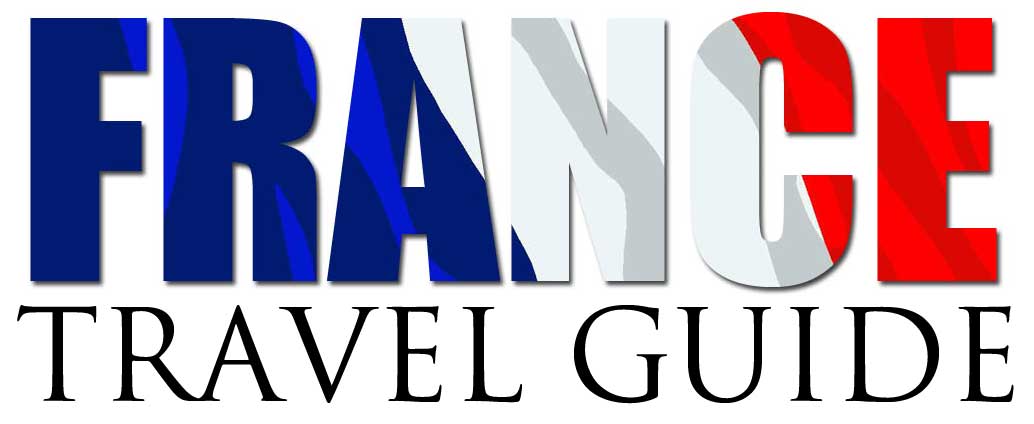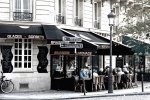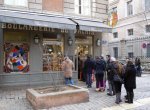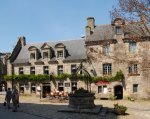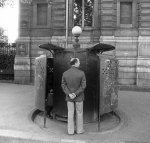chartres
department: eure-et-loir (28)
region: centre
CHARTRES: the town beyond the towers
From whichever direction you approach Chartres, it is the two steepled bell towers of the cathedral, one ornate, built in Flamboyant Gothic style in the 16th century, the other, Romanesque, quite plain by comparison, soaring high above the Beauce Plain that first proclaim the whereabouts of the city.
Gradually, the cathedral, floating in a distant haze, materialises above fields of golden wheat or sunflowers, its position on a hill above both the town and the River Eure, becoming clearer little by little. But not until the last moment, or so it seems, does the town itself materialise, spread about the cathedral in a haphazard mosaic of pan-tiled roofs, pinnacles, half-timbered houses and limestone walls that crowd the narrow lanes leading down to the river.
By cathedral-building standards, Chartres was something of a rush job, being substantially completed within less than thirty years, after a fire in 1194 had destroyed most of the city. For latter-day visitors and architects alike, the most significant consequence of this TGV-like workmanship is a cathedral that is architecturally both coherent and harmonious, the finest example of the Gothic style in the world, and an inspiration to the church builders who followed. No mean feat considering the many wars and countless religious upheavals that took place in France during the last millennium. It was inscribed as a World Heritage Site in 1979.
Place de la Poissonnerie [fishmongers' square] still has a
group of very beautiful buildings including the Maison du Saumon [Salmon House]
and the Maison de la Truie [Sow House] close by. This district is known to be
where fish were sold from the beginning of the 15th century; the last stall
disappeared after 1950.
© ATOUT FRANCE/CRT Centre - Val de Loire/P. Duriez
Close by the market, the rue des Grenets (named after an old Chartres family) leads into the rue des Changes, where, from the 11th until the 15th century, money-changers stood at benches, their place of business. 'Bench' in French is 'banc', the origin of the word 'bank', and so the money people became known as 'banquiers', or as we call them now, 'bankers'. Today, this is the site of the Saturday livestock market, a buzzing, bustling, rambunctious place where geese and people meet, disembowelled rabbits hang beside unplucked pheasants, young ducklings in crates, unaware of their fate, fascinate passing children, and from first-floor apartments the rhythms of the Manic Street Preachers clash with Edith Piaf and Simply Red.
The street names are a clue to the busy commercial past of Chartres: the rue de la Poissonnerie leads to the site of the former fish market at the Tertre de la Poissonnerie, and the lovely 16th-century, half-timbered Maison du Saumon also known as the Maison de la Truie qui File (the House of the Spinning Sow). The building is decorated with wood carvings that are ornate and skilfully executed - a salmon, a pig, angels, vines, butterflies and birds. The rue de la Petite Cordonnerie (Shoemaker's Street) and the rue aux Herbes (Herb Street) lead back to the cathedral square, and a building that cannot be ignored.
Chartres' Notre-Dame Cathedral, a symbol of the influence of
the town and Christianity, was constructed in the 13th century. Its famous stained-glass
windows cover an area of 2,500m². The maze inside the cathedral is one of the
biggest in the world (261 metres).
© ATOUT FRANCE/R-Cast
Chartres, one of the first urban conservation sites in France, is very much a success story. Its quirky cobbled streets and half-timbered houses are not all that contribute to an appealing ambience for here, too, there are also steep lanes (tertres) that lead down to the river linking the high and the low towns, humpback stone bridges and numerous public washhouses (lavoirs) where, until the middle of the 20th century, women did their washing, using a pulley system that raised or lowered the scrubbing boards dependent upon the height of the river.
Yet in spite of the world renown of its cathedral, Chartres is a delightfully unpretentious place, its department – Eure-et-Loir – largely unknown. It is the most northerly of the départements of the Région Centre, yet it has much in common with Normandy, Ile de France and the adjacent Loire and Loir valleys. It is all very relaxing, unassuming and welcoming, an ideal place to spend an agreeable few days, almost off the beaten track.
© ATOUT FRANCE/Patrice Thébault
From the terrace behind the Episcopal Palace the way through a tiered garden leads to a doorway giving onto the Tertre St Nicholas. A short distance away is the steep-sloping rue Chantault in which number 29, the Maison Romane, is the oldest inhabited house in Chartres, dating from the 12th century, its windows decorated with curious Romanesque sculptures depicting heads, acrobats, monsters and demons. Across the river, the rue de la Tannerie leads to the rue du Bourg, where you cross the Pont Bouju – one of the traditional entry points to the walled city – and on to the rue des Ecuyers (the street of the Equeries). Here are some fine 15th- and 16th-century houses, one, number 25, is the Maison de l'Escalier de la Reine Berthe, a house with a remarkable external spiral staircase, though there is no link between the 11th-century wife of King Robert II, and this 16th-century house.
In complete contrast, the modern town is typically boulevard France with busy shops, pavement cafés, restaurants, living statues, markets and the occasional iron pissoir (Gents only, of course). Along the Boulevard de la Résistance stands an impressive memorial to Jean Moulin, hero of the French Resistance during the second World War. He was Prefect of Eure-et-Loir when the Nazis occupied Chartres in 1940. Under torture he refused to sign papers alleging atrocities of the French Army, and after his release was responsible for organising the French Resistance, and, as 'Max', became a legendary figure. He was arrested by the Gestapo in 1943, and died at the hands of Klaus Barbie.

© ATOUT FRANCE/Patrice Thébault
TOURIST INFORMATION
Chartres Tourist Office
Place de la Poissonnerie, 28008 Chartres.
Tel: 02 37 18 26 26
www.chartres-tourisme.com.
Recent Articles
-
French Food and Drink - No BS Guide for lovers of Food, Wine, Liqueurs
Aug 28, 19 03:18 AM
Our guide to French food and drink for those who love traditional French food along with our no BS guide to understanding French wine and liqueurs
-
Things To Do In Carcassonne The Ultimate Tourist Guide
Aug 24, 19 06:26 PM
The ultimate tourist guide to things to do in Carcassonne when you visit this wonderful town in Aude France. Discover the places to go and see in Carcassone.
-
Lyon Old Town Guide to Vieux Lyon
Aug 18, 19 07:48 AM
Your complete guide to Lyon old town otherwise known as the Vieux Lyon. Don't miss this amazing part of the city if you're visiting Lyon in France.
-
18 French Villages You Must Visit Most Beautiful Villages in France
Aug 17, 19 06:31 AM
Our guide to the 18 most beautiful French villages you simply must visit. Loads of info, photos and facts in our ultimate villages in France tourist guide
-
What a Pissoir - The True Story of France's Unique Urinals
Aug 13, 19 03:47 PM
Is there anything more French than a pissoir? Sadly on the decline nevertheless the pissor is an endring image of the country. This is their story
chartres pass
Chartres Pass offers you the entrance to nine of the city’s attractions and grants you discount prices or special offers on hotels, restaurants or other cultural and leisure attractions.
